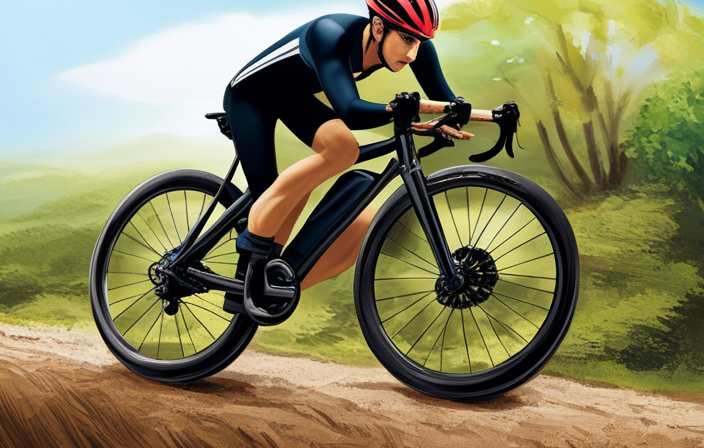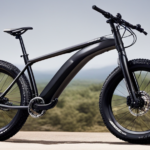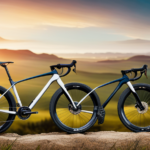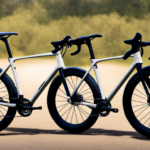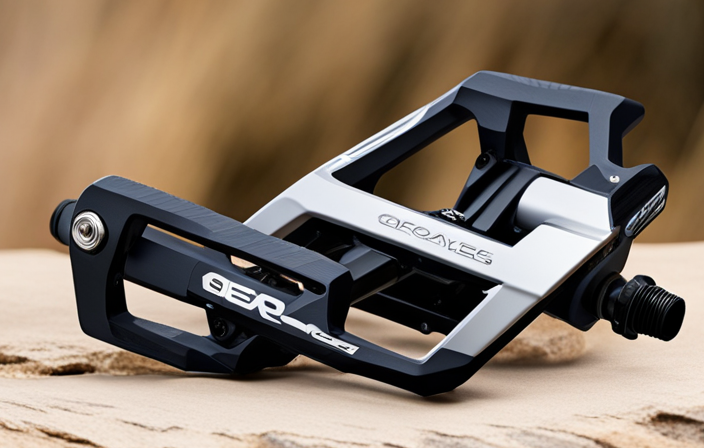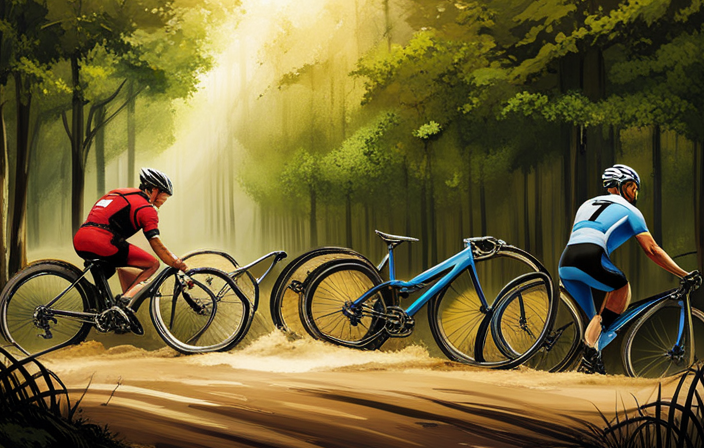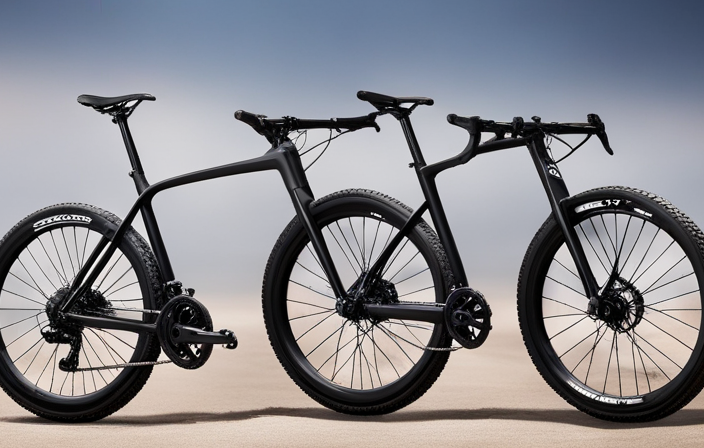Ever curious about the experience of cycling on gravel roads? Allow me to guide you through an exploration into the realm of gravel cycling adventures.
It’s not just about the rugged terrain and exhilarating challenges; it’s also about embracing a sense of freedom and exploration.
In this article, we’ll delve into the origins of gravel bike riding, the equipment needed, finding the perfect routes, training tips, safety precautions, and even how it can be used for commuting or as a social activity.
So hop on your virtual saddle and let’s dive into the exciting world of gravel bike riding!
Key Takeaways
- Gravel bike riding originated as a way to explore new terrains and landscapes.
- To participate in gravel bike riding, you will need specific equipment such as a gravel bike and appropriate safety gear.
- Finding the perfect gravel routes is important for an enjoyable riding experience.
- Gravel bike riding offers various benefits, including improved fitness and health, and it is becoming a popular trend in the cycling community.
The Origins of Gravel Bike Riding
The origins of gravel bike riding can be traced back to the early 2000s. It all began with a group of adventurous cyclists who were looking for new ways to explore the world on two wheels. They wanted to break away from the confines of traditional road cycling and mountain biking, and instead, venture off onto uncharted paths and discover new terrains and landscapes. This desire for exploration led them to create a new style of cycling that combined elements of both road and mountain biking – thus, gravel bike riding was born.
Gravel bike riding quickly gained popularity among outdoor enthusiasts for its versatility and sense of adventure. With its wider tires and sturdy frame, a gravel bike allows riders to tackle various surfaces such as dirt roads, gravel paths, and even singletrack trails. It provides the perfect balance between speed on paved roads and stability off-road, making it an ideal choice for those seeking thrilling experiences in nature.
Transitioning into the subsequent section about equipment needed for gravel bike riding: Now that we understand the origins of this exciting sport, let’s dive into what you need to get started on your own gravel biking adventures.
Equipment Needed for Gravel Bike Riding
When it comes to gravel bike riding, choosing the right bike is essential. A gravel bike is designed to handle both paved roads and rough terrain, so it’s important to find one that fits your needs and preferences.
Additionally, having the right gear and accessories can make all the difference in your riding experience. From helmets and gloves to water bottles and saddlebags, these items are crucial for comfort, safety, and convenience on your gravel adventures.
Choosing the Right Bike
To choose the right bike for gravel riding, you’ll want to consider factors like frame material and tire width.
When it comes to bike sizing, finding the proper fit is crucial for a comfortable and efficient ride. The size of the bike frame should be suitable for your height and body proportions, allowing you to maintain a natural riding position.
Additionally, take into account the components of the bike such as gears, brakes, and suspension. These elements can greatly impact your biking experience on different terrains.
As for tire width, wider tires provide better traction and stability on loose gravel surfaces.
Once you’ve found the perfect bike that suits your needs and preferences, it’s time to explore essential gear and accessories that will enhance your gravel riding adventures seamlessly.
Essential Gear and Accessories
One important aspect of gravel riding is having the right gear and accessories to enhance your experience. When it comes to bikepacking essentials, a sturdy backpack or saddlebag is crucial for carrying all your gear, such as extra clothing, food, water, and tools. Additionally, investing in a good pair of cycling shoes with grippy soles will provide stability and comfort on rough terrain. Don’t forget to wear a helmet for safety! Other essential accessories include gloves for protection and grip, sunglasses to shield your eyes from dust and debris, and a reliable GPS device or smartphone app to navigate gravel bikepacking routes effectively. All these gear and accessories contribute greatly to an enjoyable gravel riding experience.
Now that you’re equipped with the necessary gear, let’s move on to finding the perfect gravel routes without missing out on any exciting spots along the way.
Finding the Perfect Gravel Routes
Finding the perfect gravel routes can be a fun and adventurous way to explore different terrains. To ensure a successful journey, it’s important to have the right tools and knowledge. Here are some tips I’ve learned along the way:
-
Best navigation tools for gravel routes: Investing in a reliable GPS device or smartphone app specifically designed for cycling can make navigating unfamiliar areas much easier. These tools often include features like turn-by-turn directions and route planning options.
-
Tips for maintaining a gravel bike in different weather conditions: Gravel riding can expose your bike to various elements, so proper maintenance is crucial. Regularly clean your bike after rides, paying special attention to removing dirt and debris from moving parts. Additionally, consider using fenders to protect your bike from mud and water splashes during wet weather.
-
Join online cycling communities: Engaging with fellow riders through online forums or social media groups dedicated to gravel biking can provide valuable insights into popular routes and hidden gems in your area.
-
Seek local advice: Local bike shops or experienced riders in your community are great resources for finding the best gravel routes nearby. They often have first-hand knowledge of scenic locations that may not be well-known.
With these tips in mind, you’ll be well-equipped to tackle any gravel adventure that comes your way! Speaking of adventures, let’s dive into some training tips for gravel bike riding.
Transitioning into subsequent section about ‘training tips for gravel bike riding’: Now that we know how to find the perfect routes, let’s focus on honing our skills and improving our performance on those exhilarating rides.
Training Tips for Gravel Bike Riding
Ready to take your gravel adventures to the next level? Let’s explore some training tips that will help you improve your skills and performance on those exhilarating rides.
When it comes to gravel bike riding, there are specific training techniques that can enhance your abilities on rough terrain. One important aspect is building endurance through longer rides or interval training. Incorporating hill repeats into your workouts can also help strengthen leg muscles and improve climbing ability. Additionally, incorporating strength and core exercises into your routine can provide stability and power while navigating challenging trails.
Another essential element for successful gravel riding is proper nutrition. Fueling your body with the right nutrients before, during, and after a ride is crucial for optimal performance. It’s important to consume a balanced diet with carbohydrates, proteins, and healthy fats to support energy levels and aid in recovery.
As we delve deeper into safety precautions and maintenance, remember that these aspects go hand in hand with training properly for gravel bike riding. By implementing the right training techniques and following a nutrition guide, you’ll be well-prepared for any adventure that comes your way on those thrilling gravel rides.
Safety Precautions and Maintenance
When it comes to gravel bike riding, ensuring your safety should be a top priority. That’s why it’s important to pay attention to bike maintenance and inspections.
Regularly checking your brakes, tires, and gears can help prevent accidents and keep you riding smoothly on rough terrain.
Additionally, don’t forget to invest in proper safety gear like a helmet and reflective clothing to make sure you’re visible to others on the road.
By taking these precautions, you can enjoy the thrill of gravel biking while staying safe and prepared for any adventure that comes your way.
Bike Maintenance and Inspections
Regular maintenance and inspections are essential for keeping your gravel bike in optimal condition.
To start, regularly cleaning your bike is crucial to prevent dirt and grime buildup that can affect performance. Use a gentle cleaner and a soft brush to clean the frame, drivetrain, and wheels.
It’s also important to check your tire pressure before every ride. The recommended tire pressure range is usually imprinted on the sidewall of the tires. Maintaining proper tire pressure not only improves traction but also prevents flats.
In addition to these tasks, it’s vital to inspect your bike for any signs of wear or damage, such as loose bolts or worn brake pads.
By taking care of regular maintenance and inspections, you’ll ensure that your gravel bike is always ready for adventure.
Now let’s move on to discussing safety gear and precautions when riding off-road trails.
Safety Gear and Precautions
It’s important to ensure you have the proper safety gear and take necessary precautions when exploring off-road trails. When riding a gravel bike, there are a few key items that can greatly enhance your safety and enjoyment.
First and foremost, always wear a bike helmet. It protects your head in case of falls or accidents.
Additionally, wearing reflective clothing is crucial for visibility, especially if you’re riding during low-light conditions.
Don’t forget to equip yourself with knee and elbow pads for added protection during rough terrains.
Lastly, invest in good quality gloves to improve grip on the handlebars and protect your hands from potential injuries.
Having the right safety gear ensures that you can ride with confidence and peace of mind.
Now let’s explore the benefits of gravel bike riding without skipping a beat.
Benefits of Gravel Bike Riding
You’ll love the benefits of gravel bike riding. Not only is it a thrilling and adventurous activity, but it also offers numerous advantages for your physical and mental well-being.
One of the key benefits is the excellent cardiovascular workout that gravel biking provides. The combination of off-road terrain and varied surfaces engages different muscle groups, giving you a full-body workout while improving your endurance and stamina.
Additionally, gravel biking allows you to explore new trails and scenic routes that you may not have discovered otherwise. It offers a sense of freedom as you ride through beautiful landscapes, enjoying nature at its finest. This outdoor experience can be incredibly rejuvenating and helps relieve stress and anxiety.
Another advantage of gravel bike riding is that it strengthens your core muscles and improves balance. The constant adjustments required to maneuver over uneven terrain engage your core muscles, resulting in increased stability both on and off the bike.
To maximize these benefits, consider incorporating training tips into your routine. Focus on interval training to improve speed and power on uphill sections or practice handling skills to navigate technical terrains more efficiently.
Joining gravel bike riding communities further enhances the overall experience by connecting with like-minded individuals who share a passion for this exhilarating sport. They provide valuable insights, group rides, and opportunities to discover new trails together.
So hop on your gravel bike today, embrace the benefits it offers, and join a thriving community that will support and inspire your cycling journey!
Joining Gravel Bike Riding Communities
Get involved in gravel bike riding communities and connect with fellow enthusiasts who share your passion for exploring new trails and experiencing the thrill of off-road cycling. Joining gravel bike riding groups is a fantastic way to meet like-minded individuals and expand your network of gravel biking friends.
Here are four reasons why you should consider becoming part of a gravel bike riding community:
-
Shared knowledge and experience: By joining a gravel bike riding group, you can tap into the collective wisdom of experienced riders. You’ll learn about the best local trails, maintenance tips, and gear recommendations.
-
Safety in numbers: Riding with others provides an extra layer of safety, especially when venturing into unfamiliar terrain. In case of any mishaps or emergencies, there will always be someone there to lend a helping hand.
-
Social connections: Gravel bike riding communities foster a sense of camaraderie and friendship. You’ll have the opportunity to bond with people who share your love for this unique sport, forming lasting connections both on and off the trails.
-
Organized events: Many gravel bike riding groups organize group rides, races, and other events throughout the year. These gatherings allow you to challenge yourself, test your skills against others, and celebrate achievements together.
By joining these communities and participating in their organized events, you’ll become more immersed in the world of gravel biking. Next up: racing and competing in gravel bike events where you can push yourself even further.
[SUBSEQUENT SECTION: Racing & Competing in Gravel Bike Events]Racing and Competing in Gravel Bike Events
Joining gravel bike riding communities can open up opportunities for racing and competing in exciting gravel bike events. These events provide a chance to test your skills, push your limits, and experience the thrill of competition. To excel in these races, it’s important to develop effective racing techniques and follow proper training strategies.
One crucial aspect of gravel bike racing is mastering different terrain types. Gravel roads can vary greatly in terms of surface conditions, from loose rocks to packed dirt. Being able to adapt your riding style to these conditions is key. Additionally, learning how to navigate through technical sections and make quick decisions on the fly will give you an edge over other competitors.
To improve performance and increase endurance, incorporating interval training into your regimen can be highly beneficial. This involves alternating between high-intensity efforts and recovery periods, simulating the demands of race conditions. It helps build strength and stamina while improving your ability to maintain a fast pace throughout the event.
Table:
| Racing Techniques | Training Strategies |
|---|---|
| Mastering terrain | Interval training |
| Navigating | Building endurance |
By honing these skills and following a well-rounded training program, you’ll be well-prepared for the challenges that await you in gravel bike racing. So lace up your shoes, hop on your bike, and get ready to explore new terrains and landscapes as we delve into this exciting aspect of gravel biking.
Exploring New Terrains and Landscapes
When it comes to exploring new terrains and landscapes on a gravel bike, there are two key points that immediately come to mind: rural and scenic routes, as well as national parks and wilderness areas.
Riding through rural areas allows me to escape the hustle and bustle of city life and immerse myself in the peacefulness of nature. These routes often wind through picturesque countryside, offering breathtaking views along the way.
On the other hand, venturing into national parks and wilderness areas provides a unique opportunity to experience untouched beauty and diverse ecosystems firsthand. The thrill of riding through these protected areas is unparalleled, as I pedal past towering mountains, dense forests, and majestic waterfalls.
So if you’re looking for an adventure that combines adrenaline-pumping cycling with awe-inspiring natural landscapes, exploring rural routes or national parks on a gravel bike is an absolute must!
Rural and Scenic Routes
Rural and scenic routes are perfect for gravel bike riding. When I venture out on my gravel bike, I am always in awe of the picturesque landscapes and the sense of freedom that comes with exploring rural areas. Here are five reasons why these routes are a must-ride:
- Rolling meadows dotted with vibrant wildflowers.
- Winding paths through dense forests, where sunlight filters through the canopy.
- Charming country roads leading to quaint villages, offering a glimpse into local life.
- Majestic mountains towering in the distance, beckoning adventure seekers.
- Serene lakes reflecting the surrounding beauty and providing a moment of tranquility.
As you pedal along these routes, you can’t help but feel connected to nature’s wonders.
And speaking of connecting with nature, next up we’ll dive into the thrilling experience of riding through national parks and wilderness areas.
National Parks and Wilderness Areas
Exploring national parks and wilderness areas on a gravel bike allows you to immerse yourself in the untouched beauty of nature. As you pedal through these pristine landscapes, you can witness breathtaking vistas, encounter diverse wildlife, and experience a sense of tranquility that only nature can provide. Gravel biking in national parks offers a unique opportunity to discover hidden gems off the beaten path, where the silence is broken only by the crunch of your tires on gravel. From towering mountains to lush forests and meandering rivers, these protected areas showcase the awe-inspiring wonders of our planet. To give you an idea of some incredible locations to explore, here’s a table highlighting a few notable national parks and wilderness areas:
| National Parks | Wilderness Areas |
|---|---|
| Yellowstone | Alaska Range |
| Yosemite | Adirondack Park |
| Grand Canyon | Boundary Waters |
With so many extraordinary places waiting to be discovered, gravel bike riding opens up endless possibilities for adventure. In the next section, we will delve into overcoming challenges in gravel bike riding without missing a beat.
(Note: Transition sentence not provided)
Overcoming Challenges in Gravel Bike Riding
To conquer challenges in gravel bike riding, you’ll need to adapt your technique and stay focused on the rough terrain ahead. It’s not just about physical strength, but also about overcoming mental barriers and strategically managing nutrition and hydration. Here are four key strategies to help you overcome these obstacles:
-
Mind over matter: Gravel bike riding can be mentally demanding, especially when faced with steep climbs or technical descents. Stay positive and maintain a strong mindset to push through any doubts or fears that may arise.
-
Fuel for success: Proper nutrition is essential for sustained energy during long rides. Pack lightweight snacks like energy bars or gels that provide a quick boost of carbohydrates. Don’t forget to hydrate regularly as well, carrying enough water or electrolyte drinks to stay hydrated throughout your ride.
-
Pace yourself: Gravel riding is a test of endurance, so it’s crucial to pace yourself accordingly. Start at a comfortable speed and gradually increase intensity as your ride progresses. This will help prevent burnout and allow you to enjoy the journey.
-
Learn from experience: Every ride presents an opportunity for growth and learning. Take note of challenges you encounter along the way and use them as lessons for future rides. Reflecting on past experiences will make you better equipped to handle similar situations in the future.
By mastering these techniques, you’ll be able to navigate the challenges of gravel bike riding with confidence and determination.
Transitioning into the subsequent section about ‘gravel bike riding for adventure and exploration,’ remember that each obstacle conquered brings us closer to discovering new paths and experiencing thrilling adventures in nature without limits.
Gravel Bike Riding for Adventure and Exploration
When it comes to gravel bike riding, one of the most exciting aspects is the opportunity for adventure and exploration. Planning overnight trips and bikepacking allows me to immerse myself in nature and experience the thrill of self-supported travel.
Multi-day tours and expeditions take this sense of exploration to the next level, allowing me to push my limits and discover new landscapes while challenging myself physically and mentally.
Planning Overnight Trips and Bikepacking
Planning overnight trips on a gravel bike involves carefully considering the necessary gear and route. When embarking on multi-day camping adventures or bikepacking trips, it’s crucial to pack efficiently and prioritize lightweight gear that won’t weigh you down during long rides.
A durable tent, sleeping bag, cooking equipment, and clothing suitable for various weather conditions are essential items to bring along. Additionally, investing in a good quality bikepacking bag system will ensure that your belongings are securely attached to your bike frame.
As for the route planning aspect, it’s important to research and choose routes that offer scenic views, interesting landmarks, and access to necessary amenities like water sources and campsites.
By meticulously preparing for overnight trips on a gravel bike with the right gear and well-planned routes, you’ll be ready for unforgettable multi-day tours and expeditions exploring new horizons without limitations.
Multi-day Tours and Expeditions
Embarking on multi-day tours and expeditions allows for unforgettable adventures exploring new horizons. These experiences are the epitome of bikepacking, where you can fully immerse yourself in the beauty of nature while challenging your physical limits.
Multi-day tours offer the opportunity to venture further from home, discovering hidden gems along the way. From rugged mountains to serene coastlines, there is a wide range of landscapes waiting to be explored on two wheels. As you pedal through diverse terrains and encounter various climates, every day presents a new set of challenges and rewards. The sense of accomplishment after completing a multi-day tour is unparalleled, leaving you with lasting memories and a desire for more adventures.
Now, let’s transition into the subsequent section about gravel bike riding for commuting and transportation; an equally exciting aspect of this versatile sport.
Gravel Bike Riding for Commuting and Transportation
To incorporate gravel bike riding into your daily commute, you can easily navigate through city streets and enjoy a smooth ride. Gravel bikes are designed to handle various terrains, from pavement to dirt paths, making them ideal for urban commuting. Not only does gravel bike riding offer a fun and adventurous way to get to work, but it also comes with several benefits.
Firstly, gravel bike commuting provides numerous health advantages. Riding a bike regularly helps improve cardiovascular fitness, strengthens muscles, and promotes weight loss. Additionally, it is a low-impact exercise that reduces the risk of joint injuries compared to other forms of transportation.
Secondly, using a gravel bike for transportation offers environmental benefits. By choosing this eco-friendly mode of travel instead of driving or taking public transportation, you contribute to reducing air pollution and carbon emissions.
Incorporating gravel bike riding into your daily commute not only has personal benefits but also positively impacts the environment. So why not make your daily commute more enjoyable while making a difference? Transitioning into the next section about ‘gravel bike riding as a social activity,’ you’ll discover how this versatile sport can also bring people together in exciting ways.
Gravel Bike Riding as a Social Activity
Engaging in gravel bike riding can foster connections and create a sense of community among enthusiasts. It’s not just about the thrill of exploring off-road trails or the physical challenge; it’s also about the social interaction that comes with group rides. When you ride with others who share the same passion for gravel bike riding, you form bonds and create lasting friendships.
Group rides are a common way for gravel bike riders to connect. These rides bring together people from different backgrounds, ages, and skill levels who all share a love for this adventurous sport. During these rides, you’ll have the opportunity to meet new people, exchange tips and tricks, and learn from more experienced riders.
The sense of community bonding that comes from gravel bike riding is truly special. Whether it’s cheering each other on as you conquer tough terrains or simply sharing stories over post-ride coffee, there is a unique camaraderie among fellow riders. You’ll find yourself surrounded by individuals who understand your enthusiasm and support your goals.
In conclusion, gravel bike riding goes beyond just pedaling through dirt roads; it is an opportunity to engage socially with like-minded individuals. The connections formed during group rides create a sense of belonging and shared experiences that enriches the overall enjoyment of this activity.
So now that we understand how gravel bike riding can be a social activity, let’s dive into some tips for getting started in this exciting world!
Tips for Getting Started in Gravel Bike Riding
Get ready to hit the dirt roads and experience the thrill of exploring off-road trails with these helpful tips for getting started in gravel bike riding. Gravel bike training is essential to build endurance and strength for this demanding activity. Start by gradually increasing your mileage and incorporating interval training to improve your speed and power on different terrains. Don’t forget to include some cross-training activities, such as hiking or running, to enhance your overall fitness.
Maintenance is key when it comes to gravel bike riding. Regularly clean your bike after each ride, paying extra attention to removing dirt and debris from the drivetrain. Check your tires for any signs of wear or cuts, as well as ensuring they are properly inflated for optimal performance on rough surfaces. Additionally, regularly inspect the brakes, gears, and chain for any issues that may affect your safety while riding.
To evoke emotion in you as a beginner gravel rider, here’s a table showcasing the thrilling aspects of this adventure-filled sport:
| Thrilling Aspects | Emotions |
|---|---|
| Exploring new trails | Excitement |
| Conquering challenging terrain | Accomplishment |
| Feeling connected with nature | Serenity |
Embrace the adventure and freedom of gravel bike riding by immersing yourself in nature’s beauty while pushing your limits on every ride.
Embracing the Adventure and Freedom of Gravel Bike Riding
Experience the thrill and freedom of exploring new trails and conquering challenging terrain on your gravel bike rides. When you embrace the adventure of gravel biking, you open yourself up to a world of excitement and discovery.
Here are some reasons why gravel bike riding is an experience like no other:
-
Unpredictability: Every ride brings a sense of unpredictability, as you never know what lies ahead. It keeps you on your toes and adds an element of excitement to each journey.
-
Connection with nature: Gravel bike riding allows you to immerse yourself in nature’s beauty. You can pedal through lush forests, alongside shimmering lakes, or up breathtaking mountain passes.
-
Finding hidden gems: Gravel roads often lead to hidden gems that are off the beaten path. These could be secluded viewpoints, picturesque picnic spots, or charming small towns waiting to be discovered.
-
Sense of accomplishment: Conquering challenging terrain on your gravel bike gives you a tremendous sense of achievement. The feeling of pushing yourself beyond your limits is truly empowering.
-
Camaraderie: Gravel biking also provides an opportunity for camaraderie with fellow riders. Sharing stories, tips, and adventures with like-minded individuals creates lasting connections.
Embrace the thrill and joy that gravel bike riding offers. Let it take you on a journey where every turn opens up new possibilities and where finding hidden gems becomes part of the adventure itself.
Frequently Asked Questions
How can I prevent flats while riding gravel?
To prevent flats while riding on gravel, I take several preventive measures.
First, I make sure to choose tires with thicker tread and puncture-resistant layers.
Additionally, maintaining the right tire pressure is crucial. I keep my tires inflated to the recommended PSI for off-road riding, as this helps to absorb impact and reduce the risk of pinch flats.
Regularly checking tire pressure before each ride is a simple yet effective way to avoid flats on gravel terrain.
What are the differences between a gravel bike and a road bike?
When comparing a gravel bike and a road bike, there are several key differences to consider.
Firstly, a gravel bike is designed to handle rougher terrains, like gravel roads or dirt trails, whereas a road bike is intended for smooth pavement.
Gravel bikes also have wider tires with more tread for better traction and stability.
Additionally, gravel bikes generally have a more relaxed geometry for enhanced comfort during longer rides.
Overall, the versatility and adaptability of a gravel bike make it ideal for exploring diverse terrain and enjoying the benefits of off-road riding without the extreme capabilities of a mountain bike.
Are there any specific safety precautions I should take when riding on gravel?
When riding on gravel, there are a few important safety precautions to keep in mind.
First, make sure your gravel bike is properly maintained, including checking the tire pressure and ensuring the brakes are in good working order.
It’s also essential to wear appropriate safety gear such as a helmet and gloves.
Consider adding accessories like fenders or extra grip handlebars for added stability and control.
Lastly, always be cautious of loose gravel and uneven terrain to avoid accidents.
How do I choose the right tire width for gravel riding?
When choosing tire width for gravel riding, it’s important to consider the benefits of wider tires. Wider tires provide better traction and stability on loose surfaces, making them ideal for tackling rough terrains. They also offer a more comfortable ride by absorbing shocks and vibrations.
However, it’s essential to find a balance between width and rolling resistance for optimal performance. Consulting with a knowledgeable bike shop or experienced riders can help you make an informed decision based on your specific needs.
Can I use my mountain bike for gravel riding?
Sure, you can definitely use your mountain bike for gravel riding!
I remember the first time I took my trusty mountain bike out on a gravel trail. It was like unleashing a wild stallion on an open field – the bike effortlessly tackled the rough terrain and gave me a thrilling ride.
Just make sure to properly maintain your mountain bike, especially the tires, as they may wear out faster on gravel surfaces.
The benefits of gravel riding include exploring new scenic trails, improving endurance and balance, and escaping the hustle and bustle of city life.
Conclusion
In conclusion, gravel bike riding is not just a hobby, but a thrilling adventure that offers freedom and excitement like no other.
It allows you to explore new paths, conquer challenging terrains, and immerse yourself in the beauty of nature.
So, grab your bike and let the tires roll on the gravel roads that lead to endless possibilities.
Remember, life is like a gravel ride – sometimes bumpy, but always worth it in the end.
So saddle up and embrace the journey!

